Analysis of Business Law Cases: Rights, Liabilities, and Contracts
VerifiedAdded on 2020/10/04
|10
|2492
|484
Report
AI Summary
This report provides a comprehensive analysis of several business law cases, examining issues of negligence, misrepresentation, and contract law. The report begins with a case involving a financial advisor's negligence, exploring the application of the Law of Negligence and Limitation of Liability Act, 2008, and the Civil Liability Act, 2002, to determine the advisor's liability and the client's right to compensation. The second case addresses misrepresentation by a city council and its impact on a property purchase, referencing the Misrepresentation Act, 1972, and the Civil Liability Act, 2002. The report then transitions to a series of cases concerning contract validity, including oral agreements, signed contracts, and lease agreements, referencing Australian contract law and the Leases (commercial and retail) Act, 2001. The final case examines the validity of a guarantee contract and the liabilities of guarantors, considering the implications of the guarantor's awareness of the contract terms. The analysis applies relevant legal principles to each case, offering conclusions on the rights and liabilities of the involved parties and the potential legal remedies available.
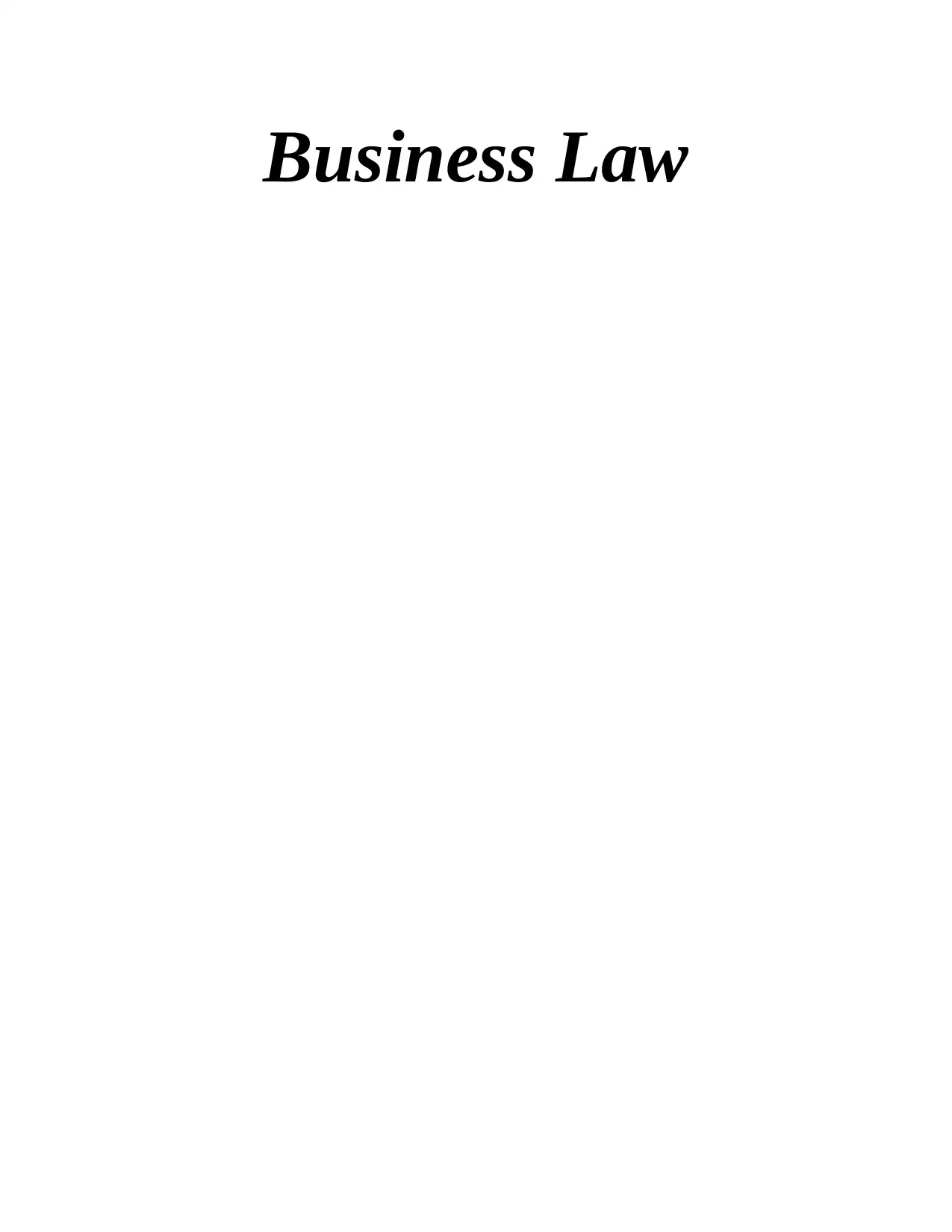
Business Law
Paraphrase This Document
Need a fresh take? Get an instant paraphrase of this document with our AI Paraphraser
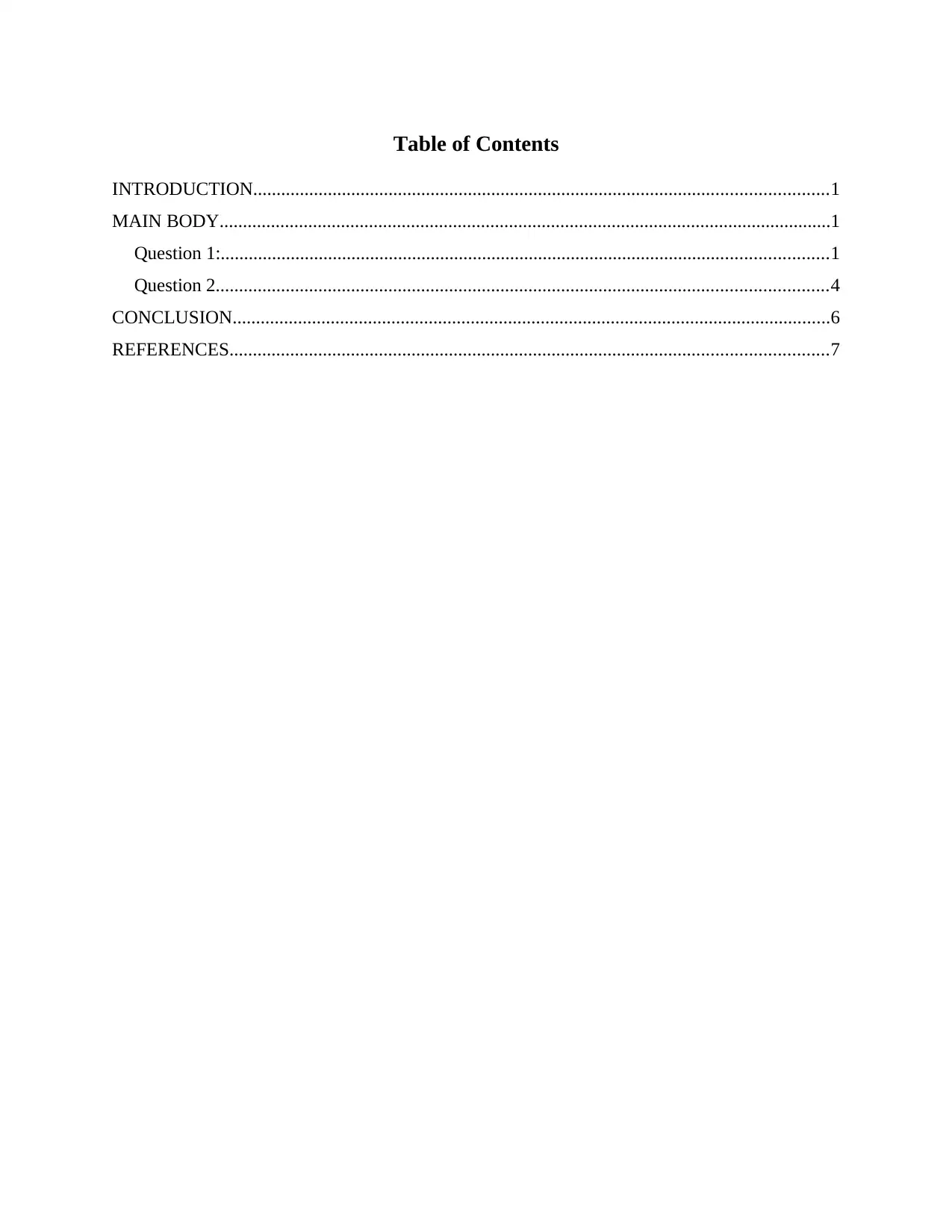
Table of Contents
INTRODUCTION...........................................................................................................................1
MAIN BODY...................................................................................................................................1
Question 1:..................................................................................................................................1
Question 2...................................................................................................................................4
CONCLUSION................................................................................................................................6
REFERENCES................................................................................................................................7
INTRODUCTION...........................................................................................................................1
MAIN BODY...................................................................................................................................1
Question 1:..................................................................................................................................1
Question 2...................................................................................................................................4
CONCLUSION................................................................................................................................6
REFERENCES................................................................................................................................7

⊘ This is a preview!⊘
Do you want full access?
Subscribe today to unlock all pages.

Trusted by 1+ million students worldwide
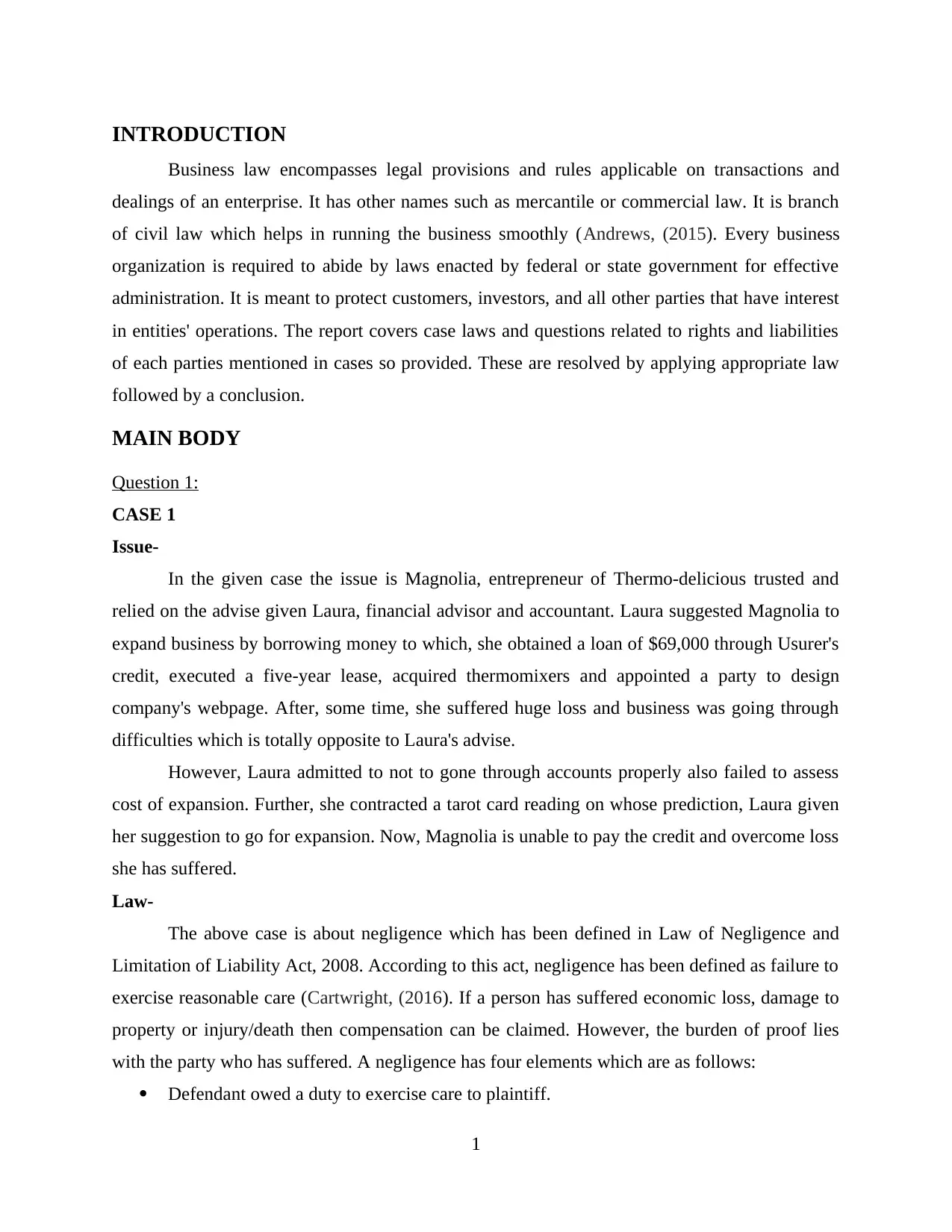
INTRODUCTION
Business law encompasses legal provisions and rules applicable on transactions and
dealings of an enterprise. It has other names such as mercantile or commercial law. It is branch
of civil law which helps in running the business smoothly (Andrews, (2015). Every business
organization is required to abide by laws enacted by federal or state government for effective
administration. It is meant to protect customers, investors, and all other parties that have interest
in entities' operations. The report covers case laws and questions related to rights and liabilities
of each parties mentioned in cases so provided. These are resolved by applying appropriate law
followed by a conclusion.
MAIN BODY
Question 1:
CASE 1
Issue-
In the given case the issue is Magnolia, entrepreneur of Thermo-delicious trusted and
relied on the advise given Laura, financial advisor and accountant. Laura suggested Magnolia to
expand business by borrowing money to which, she obtained a loan of $69,000 through Usurer's
credit, executed a five-year lease, acquired thermomixers and appointed a party to design
company's webpage. After, some time, she suffered huge loss and business was going through
difficulties which is totally opposite to Laura's advise.
However, Laura admitted to not to gone through accounts properly also failed to assess
cost of expansion. Further, she contracted a tarot card reading on whose prediction, Laura given
her suggestion to go for expansion. Now, Magnolia is unable to pay the credit and overcome loss
she has suffered.
Law-
The above case is about negligence which has been defined in Law of Negligence and
Limitation of Liability Act, 2008. According to this act, negligence has been defined as failure to
exercise reasonable care (Cartwright, (2016). If a person has suffered economic loss, damage to
property or injury/death then compensation can be claimed. However, the burden of proof lies
with the party who has suffered. A negligence has four elements which are as follows:
Defendant owed a duty to exercise care to plaintiff.
1
Business law encompasses legal provisions and rules applicable on transactions and
dealings of an enterprise. It has other names such as mercantile or commercial law. It is branch
of civil law which helps in running the business smoothly (Andrews, (2015). Every business
organization is required to abide by laws enacted by federal or state government for effective
administration. It is meant to protect customers, investors, and all other parties that have interest
in entities' operations. The report covers case laws and questions related to rights and liabilities
of each parties mentioned in cases so provided. These are resolved by applying appropriate law
followed by a conclusion.
MAIN BODY
Question 1:
CASE 1
Issue-
In the given case the issue is Magnolia, entrepreneur of Thermo-delicious trusted and
relied on the advise given Laura, financial advisor and accountant. Laura suggested Magnolia to
expand business by borrowing money to which, she obtained a loan of $69,000 through Usurer's
credit, executed a five-year lease, acquired thermomixers and appointed a party to design
company's webpage. After, some time, she suffered huge loss and business was going through
difficulties which is totally opposite to Laura's advise.
However, Laura admitted to not to gone through accounts properly also failed to assess
cost of expansion. Further, she contracted a tarot card reading on whose prediction, Laura given
her suggestion to go for expansion. Now, Magnolia is unable to pay the credit and overcome loss
she has suffered.
Law-
The above case is about negligence which has been defined in Law of Negligence and
Limitation of Liability Act, 2008. According to this act, negligence has been defined as failure to
exercise reasonable care (Cartwright, (2016). If a person has suffered economic loss, damage to
property or injury/death then compensation can be claimed. However, the burden of proof lies
with the party who has suffered. A negligence has four elements which are as follows:
Defendant owed a duty to exercise care to plaintiff.
1
Paraphrase This Document
Need a fresh take? Get an instant paraphrase of this document with our AI Paraphraser
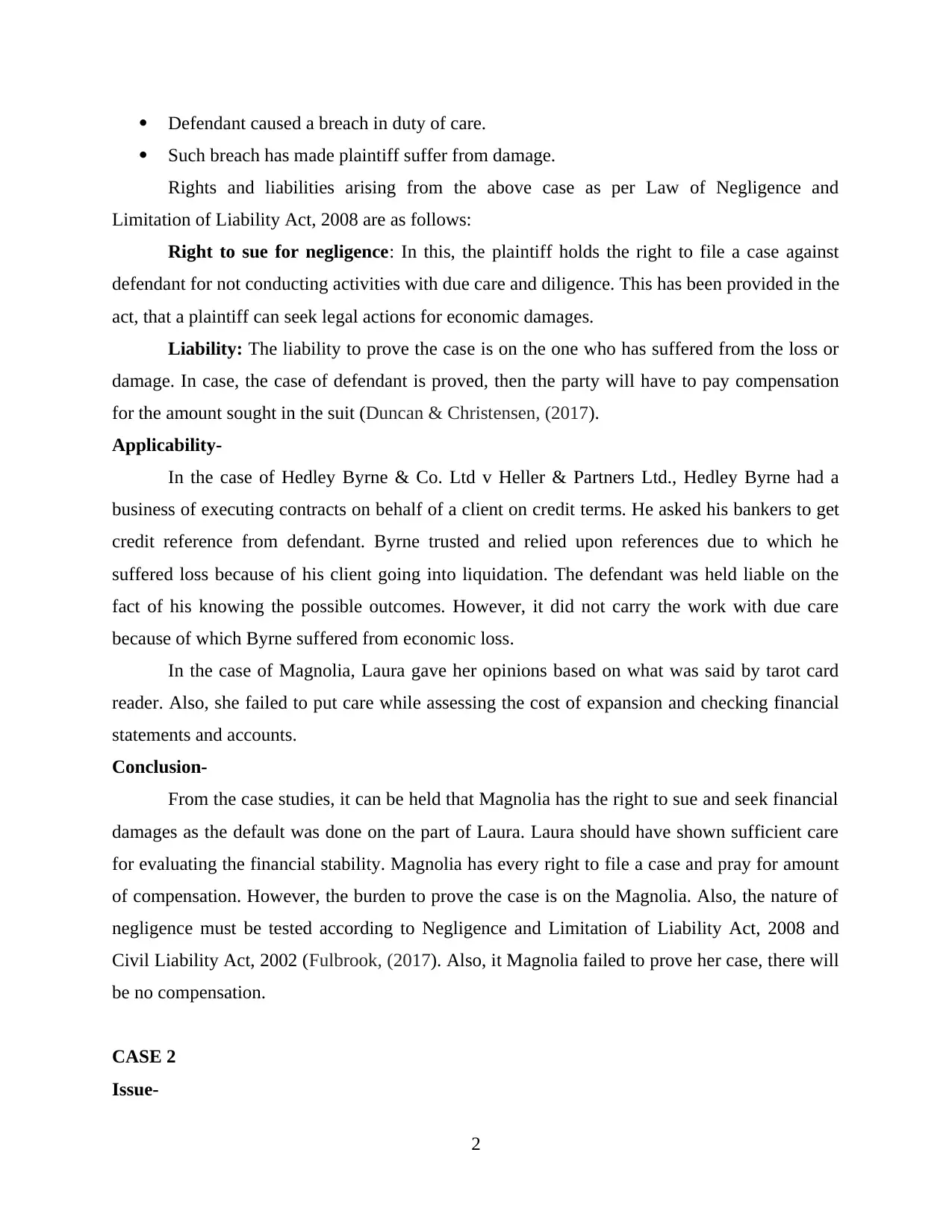
Defendant caused a breach in duty of care.
Such breach has made plaintiff suffer from damage.
Rights and liabilities arising from the above case as per Law of Negligence and
Limitation of Liability Act, 2008 are as follows:
Right to sue for negligence: In this, the plaintiff holds the right to file a case against
defendant for not conducting activities with due care and diligence. This has been provided in the
act, that a plaintiff can seek legal actions for economic damages.
Liability: The liability to prove the case is on the one who has suffered from the loss or
damage. In case, the case of defendant is proved, then the party will have to pay compensation
for the amount sought in the suit (Duncan & Christensen, (2017).
Applicability-
In the case of Hedley Byrne & Co. Ltd v Heller & Partners Ltd., Hedley Byrne had a
business of executing contracts on behalf of a client on credit terms. He asked his bankers to get
credit reference from defendant. Byrne trusted and relied upon references due to which he
suffered loss because of his client going into liquidation. The defendant was held liable on the
fact of his knowing the possible outcomes. However, it did not carry the work with due care
because of which Byrne suffered from economic loss.
In the case of Magnolia, Laura gave her opinions based on what was said by tarot card
reader. Also, she failed to put care while assessing the cost of expansion and checking financial
statements and accounts.
Conclusion-
From the case studies, it can be held that Magnolia has the right to sue and seek financial
damages as the default was done on the part of Laura. Laura should have shown sufficient care
for evaluating the financial stability. Magnolia has every right to file a case and pray for amount
of compensation. However, the burden to prove the case is on the Magnolia. Also, the nature of
negligence must be tested according to Negligence and Limitation of Liability Act, 2008 and
Civil Liability Act, 2002 (Fulbrook, (2017). Also, it Magnolia failed to prove her case, there will
be no compensation.
CASE 2
Issue-
2
Such breach has made plaintiff suffer from damage.
Rights and liabilities arising from the above case as per Law of Negligence and
Limitation of Liability Act, 2008 are as follows:
Right to sue for negligence: In this, the plaintiff holds the right to file a case against
defendant for not conducting activities with due care and diligence. This has been provided in the
act, that a plaintiff can seek legal actions for economic damages.
Liability: The liability to prove the case is on the one who has suffered from the loss or
damage. In case, the case of defendant is proved, then the party will have to pay compensation
for the amount sought in the suit (Duncan & Christensen, (2017).
Applicability-
In the case of Hedley Byrne & Co. Ltd v Heller & Partners Ltd., Hedley Byrne had a
business of executing contracts on behalf of a client on credit terms. He asked his bankers to get
credit reference from defendant. Byrne trusted and relied upon references due to which he
suffered loss because of his client going into liquidation. The defendant was held liable on the
fact of his knowing the possible outcomes. However, it did not carry the work with due care
because of which Byrne suffered from economic loss.
In the case of Magnolia, Laura gave her opinions based on what was said by tarot card
reader. Also, she failed to put care while assessing the cost of expansion and checking financial
statements and accounts.
Conclusion-
From the case studies, it can be held that Magnolia has the right to sue and seek financial
damages as the default was done on the part of Laura. Laura should have shown sufficient care
for evaluating the financial stability. Magnolia has every right to file a case and pray for amount
of compensation. However, the burden to prove the case is on the Magnolia. Also, the nature of
negligence must be tested according to Negligence and Limitation of Liability Act, 2008 and
Civil Liability Act, 2002 (Fulbrook, (2017). Also, it Magnolia failed to prove her case, there will
be no compensation.
CASE 2
Issue-
2
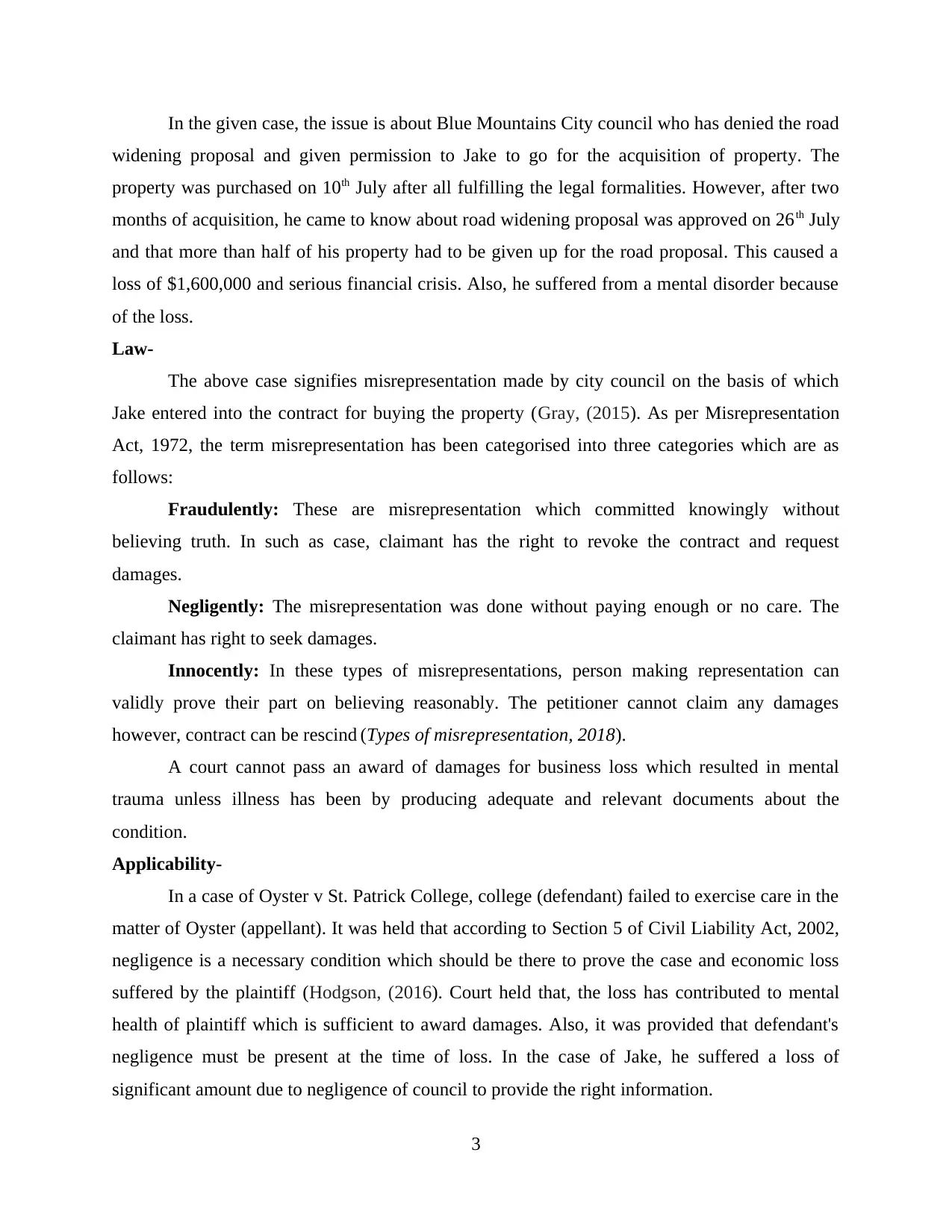
In the given case, the issue is about Blue Mountains City council who has denied the road
widening proposal and given permission to Jake to go for the acquisition of property. The
property was purchased on 10th July after all fulfilling the legal formalities. However, after two
months of acquisition, he came to know about road widening proposal was approved on 26th July
and that more than half of his property had to be given up for the road proposal. This caused a
loss of $1,600,000 and serious financial crisis. Also, he suffered from a mental disorder because
of the loss.
Law-
The above case signifies misrepresentation made by city council on the basis of which
Jake entered into the contract for buying the property (Gray, (2015). As per Misrepresentation
Act, 1972, the term misrepresentation has been categorised into three categories which are as
follows:
Fraudulently: These are misrepresentation which committed knowingly without
believing truth. In such as case, claimant has the right to revoke the contract and request
damages.
Negligently: The misrepresentation was done without paying enough or no care. The
claimant has right to seek damages.
Innocently: In these types of misrepresentations, person making representation can
validly prove their part on believing reasonably. The petitioner cannot claim any damages
however, contract can be rescind (Types of misrepresentation, 2018).
A court cannot pass an award of damages for business loss which resulted in mental
trauma unless illness has been by producing adequate and relevant documents about the
condition.
Applicability-
In a case of Oyster v St. Patrick College, college (defendant) failed to exercise care in the
matter of Oyster (appellant). It was held that according to Section 5 of Civil Liability Act, 2002,
negligence is a necessary condition which should be there to prove the case and economic loss
suffered by the plaintiff (Hodgson, (2016). Court held that, the loss has contributed to mental
health of plaintiff which is sufficient to award damages. Also, it was provided that defendant's
negligence must be present at the time of loss. In the case of Jake, he suffered a loss of
significant amount due to negligence of council to provide the right information.
3
widening proposal and given permission to Jake to go for the acquisition of property. The
property was purchased on 10th July after all fulfilling the legal formalities. However, after two
months of acquisition, he came to know about road widening proposal was approved on 26th July
and that more than half of his property had to be given up for the road proposal. This caused a
loss of $1,600,000 and serious financial crisis. Also, he suffered from a mental disorder because
of the loss.
Law-
The above case signifies misrepresentation made by city council on the basis of which
Jake entered into the contract for buying the property (Gray, (2015). As per Misrepresentation
Act, 1972, the term misrepresentation has been categorised into three categories which are as
follows:
Fraudulently: These are misrepresentation which committed knowingly without
believing truth. In such as case, claimant has the right to revoke the contract and request
damages.
Negligently: The misrepresentation was done without paying enough or no care. The
claimant has right to seek damages.
Innocently: In these types of misrepresentations, person making representation can
validly prove their part on believing reasonably. The petitioner cannot claim any damages
however, contract can be rescind (Types of misrepresentation, 2018).
A court cannot pass an award of damages for business loss which resulted in mental
trauma unless illness has been by producing adequate and relevant documents about the
condition.
Applicability-
In a case of Oyster v St. Patrick College, college (defendant) failed to exercise care in the
matter of Oyster (appellant). It was held that according to Section 5 of Civil Liability Act, 2002,
negligence is a necessary condition which should be there to prove the case and economic loss
suffered by the plaintiff (Hodgson, (2016). Court held that, the loss has contributed to mental
health of plaintiff which is sufficient to award damages. Also, it was provided that defendant's
negligence must be present at the time of loss. In the case of Jake, he suffered a loss of
significant amount due to negligence of council to provide the right information.
3
⊘ This is a preview!⊘
Do you want full access?
Subscribe today to unlock all pages.

Trusted by 1+ million students worldwide
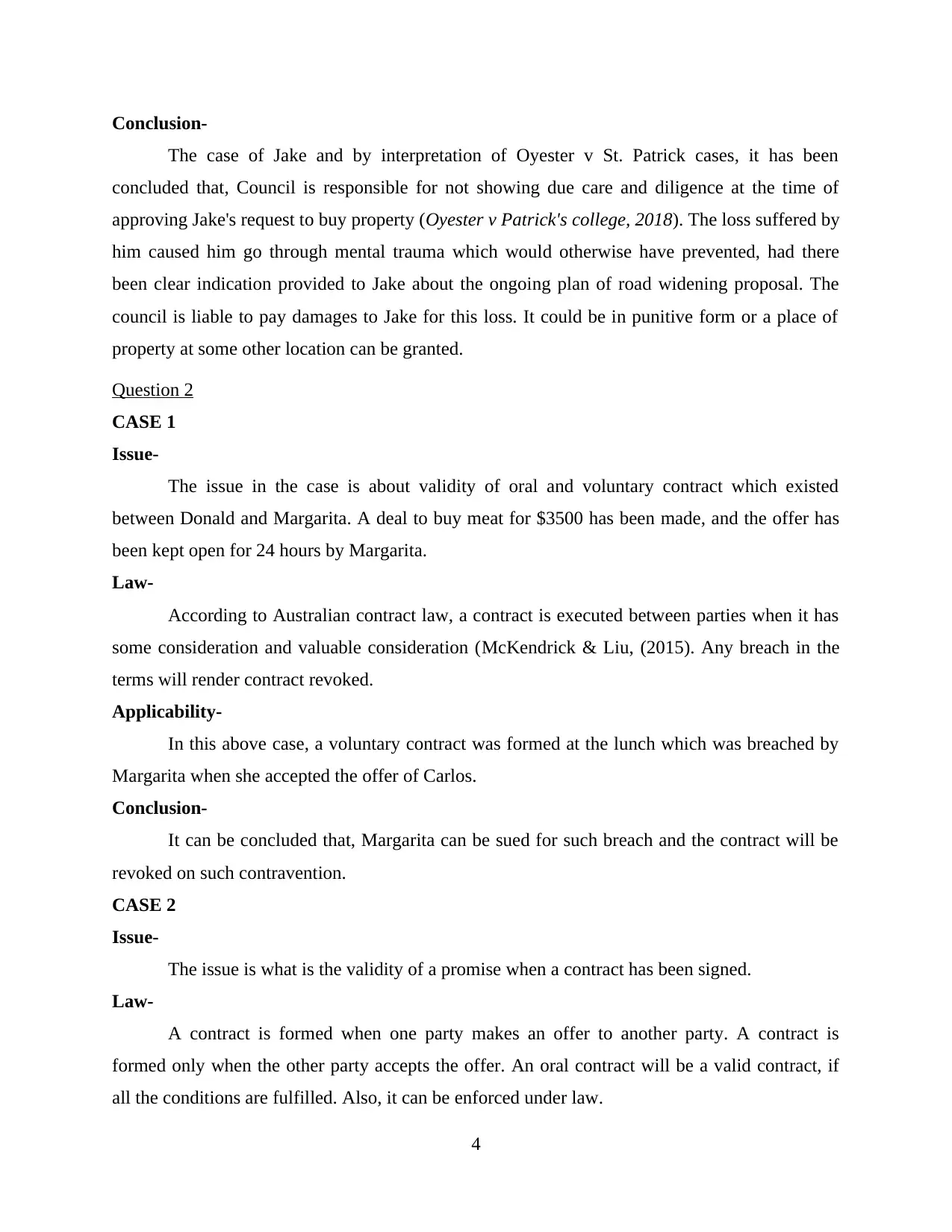
Conclusion-
The case of Jake and by interpretation of Oyester v St. Patrick cases, it has been
concluded that, Council is responsible for not showing due care and diligence at the time of
approving Jake's request to buy property (Oyester v Patrick's college, 2018). The loss suffered by
him caused him go through mental trauma which would otherwise have prevented, had there
been clear indication provided to Jake about the ongoing plan of road widening proposal. The
council is liable to pay damages to Jake for this loss. It could be in punitive form or a place of
property at some other location can be granted.
Question 2
CASE 1
Issue-
The issue in the case is about validity of oral and voluntary contract which existed
between Donald and Margarita. A deal to buy meat for $3500 has been made, and the offer has
been kept open for 24 hours by Margarita.
Law-
According to Australian contract law, a contract is executed between parties when it has
some consideration and valuable consideration (McKendrick & Liu, (2015). Any breach in the
terms will render contract revoked.
Applicability-
In this above case, a voluntary contract was formed at the lunch which was breached by
Margarita when she accepted the offer of Carlos.
Conclusion-
It can be concluded that, Margarita can be sued for such breach and the contract will be
revoked on such contravention.
CASE 2
Issue-
The issue is what is the validity of a promise when a contract has been signed.
Law-
A contract is formed when one party makes an offer to another party. A contract is
formed only when the other party accepts the offer. An oral contract will be a valid contract, if
all the conditions are fulfilled. Also, it can be enforced under law.
4
The case of Jake and by interpretation of Oyester v St. Patrick cases, it has been
concluded that, Council is responsible for not showing due care and diligence at the time of
approving Jake's request to buy property (Oyester v Patrick's college, 2018). The loss suffered by
him caused him go through mental trauma which would otherwise have prevented, had there
been clear indication provided to Jake about the ongoing plan of road widening proposal. The
council is liable to pay damages to Jake for this loss. It could be in punitive form or a place of
property at some other location can be granted.
Question 2
CASE 1
Issue-
The issue in the case is about validity of oral and voluntary contract which existed
between Donald and Margarita. A deal to buy meat for $3500 has been made, and the offer has
been kept open for 24 hours by Margarita.
Law-
According to Australian contract law, a contract is executed between parties when it has
some consideration and valuable consideration (McKendrick & Liu, (2015). Any breach in the
terms will render contract revoked.
Applicability-
In this above case, a voluntary contract was formed at the lunch which was breached by
Margarita when she accepted the offer of Carlos.
Conclusion-
It can be concluded that, Margarita can be sued for such breach and the contract will be
revoked on such contravention.
CASE 2
Issue-
The issue is what is the validity of a promise when a contract has been signed.
Law-
A contract is formed when one party makes an offer to another party. A contract is
formed only when the other party accepts the offer. An oral contract will be a valid contract, if
all the conditions are fulfilled. Also, it can be enforced under law.
4
Paraphrase This Document
Need a fresh take? Get an instant paraphrase of this document with our AI Paraphraser
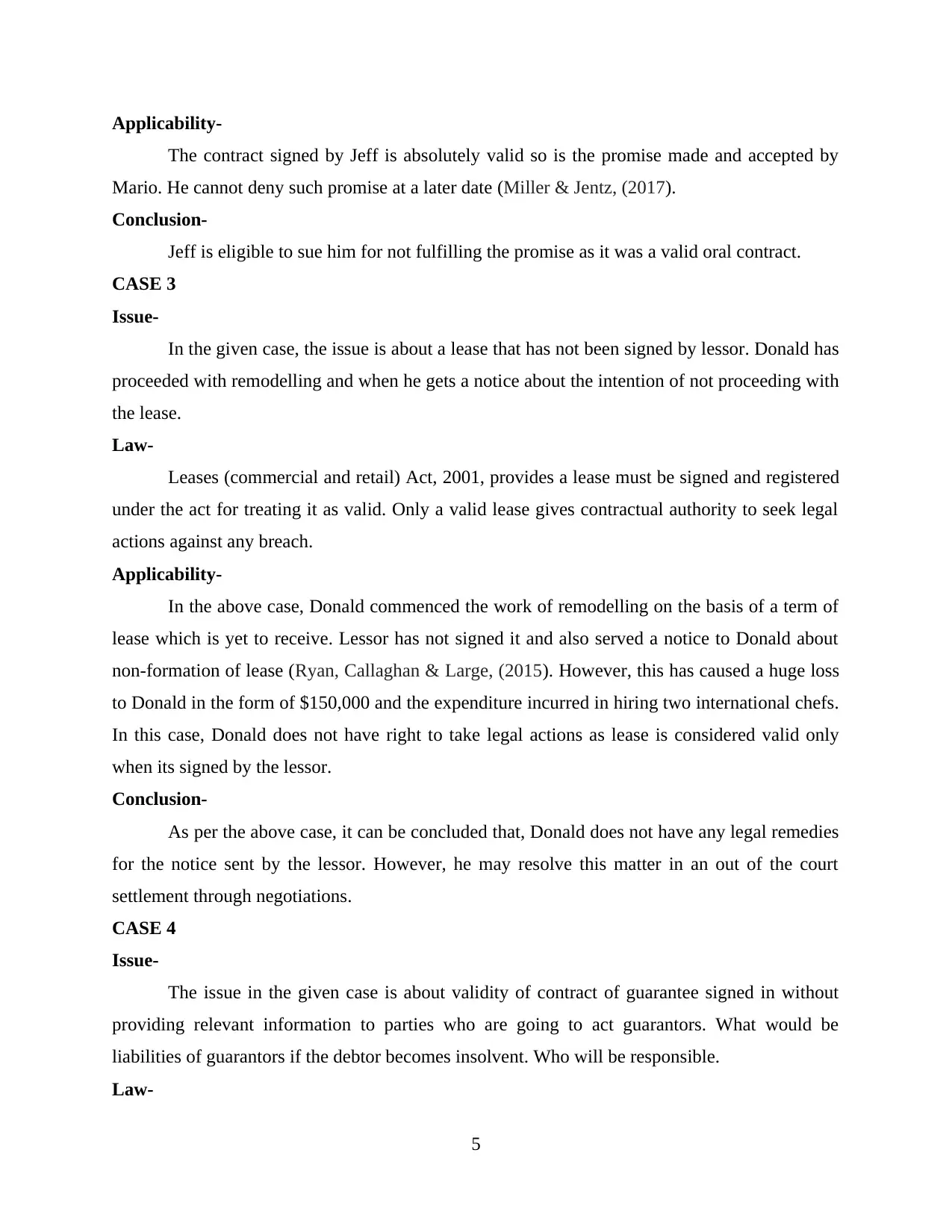
Applicability-
The contract signed by Jeff is absolutely valid so is the promise made and accepted by
Mario. He cannot deny such promise at a later date (Miller & Jentz, (2017).
Conclusion-
Jeff is eligible to sue him for not fulfilling the promise as it was a valid oral contract.
CASE 3
Issue-
In the given case, the issue is about a lease that has not been signed by lessor. Donald has
proceeded with remodelling and when he gets a notice about the intention of not proceeding with
the lease.
Law-
Leases (commercial and retail) Act, 2001, provides a lease must be signed and registered
under the act for treating it as valid. Only a valid lease gives contractual authority to seek legal
actions against any breach.
Applicability-
In the above case, Donald commenced the work of remodelling on the basis of a term of
lease which is yet to receive. Lessor has not signed it and also served a notice to Donald about
non-formation of lease (Ryan, Callaghan & Large, (2015). However, this has caused a huge loss
to Donald in the form of $150,000 and the expenditure incurred in hiring two international chefs.
In this case, Donald does not have right to take legal actions as lease is considered valid only
when its signed by the lessor.
Conclusion-
As per the above case, it can be concluded that, Donald does not have any legal remedies
for the notice sent by the lessor. However, he may resolve this matter in an out of the court
settlement through negotiations.
CASE 4
Issue-
The issue in the given case is about validity of contract of guarantee signed in without
providing relevant information to parties who are going to act guarantors. What would be
liabilities of guarantors if the debtor becomes insolvent. Who will be responsible.
Law-
5
The contract signed by Jeff is absolutely valid so is the promise made and accepted by
Mario. He cannot deny such promise at a later date (Miller & Jentz, (2017).
Conclusion-
Jeff is eligible to sue him for not fulfilling the promise as it was a valid oral contract.
CASE 3
Issue-
In the given case, the issue is about a lease that has not been signed by lessor. Donald has
proceeded with remodelling and when he gets a notice about the intention of not proceeding with
the lease.
Law-
Leases (commercial and retail) Act, 2001, provides a lease must be signed and registered
under the act for treating it as valid. Only a valid lease gives contractual authority to seek legal
actions against any breach.
Applicability-
In the above case, Donald commenced the work of remodelling on the basis of a term of
lease which is yet to receive. Lessor has not signed it and also served a notice to Donald about
non-formation of lease (Ryan, Callaghan & Large, (2015). However, this has caused a huge loss
to Donald in the form of $150,000 and the expenditure incurred in hiring two international chefs.
In this case, Donald does not have right to take legal actions as lease is considered valid only
when its signed by the lessor.
Conclusion-
As per the above case, it can be concluded that, Donald does not have any legal remedies
for the notice sent by the lessor. However, he may resolve this matter in an out of the court
settlement through negotiations.
CASE 4
Issue-
The issue in the given case is about validity of contract of guarantee signed in without
providing relevant information to parties who are going to act guarantors. What would be
liabilities of guarantors if the debtor becomes insolvent. Who will be responsible.
Law-
5
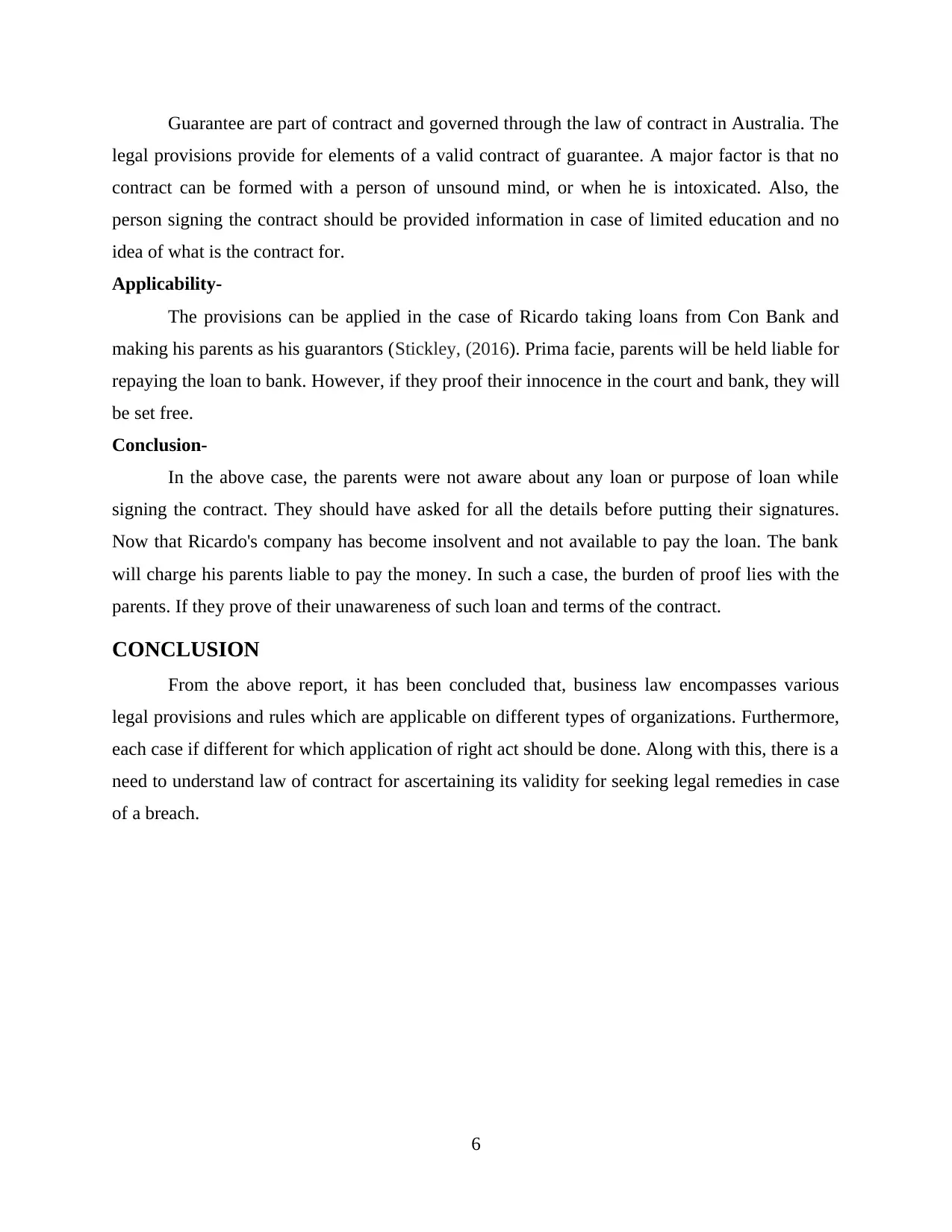
Guarantee are part of contract and governed through the law of contract in Australia. The
legal provisions provide for elements of a valid contract of guarantee. A major factor is that no
contract can be formed with a person of unsound mind, or when he is intoxicated. Also, the
person signing the contract should be provided information in case of limited education and no
idea of what is the contract for.
Applicability-
The provisions can be applied in the case of Ricardo taking loans from Con Bank and
making his parents as his guarantors (Stickley, (2016). Prima facie, parents will be held liable for
repaying the loan to bank. However, if they proof their innocence in the court and bank, they will
be set free.
Conclusion-
In the above case, the parents were not aware about any loan or purpose of loan while
signing the contract. They should have asked for all the details before putting their signatures.
Now that Ricardo's company has become insolvent and not available to pay the loan. The bank
will charge his parents liable to pay the money. In such a case, the burden of proof lies with the
parents. If they prove of their unawareness of such loan and terms of the contract.
CONCLUSION
From the above report, it has been concluded that, business law encompasses various
legal provisions and rules which are applicable on different types of organizations. Furthermore,
each case if different for which application of right act should be done. Along with this, there is a
need to understand law of contract for ascertaining its validity for seeking legal remedies in case
of a breach.
6
legal provisions provide for elements of a valid contract of guarantee. A major factor is that no
contract can be formed with a person of unsound mind, or when he is intoxicated. Also, the
person signing the contract should be provided information in case of limited education and no
idea of what is the contract for.
Applicability-
The provisions can be applied in the case of Ricardo taking loans from Con Bank and
making his parents as his guarantors (Stickley, (2016). Prima facie, parents will be held liable for
repaying the loan to bank. However, if they proof their innocence in the court and bank, they will
be set free.
Conclusion-
In the above case, the parents were not aware about any loan or purpose of loan while
signing the contract. They should have asked for all the details before putting their signatures.
Now that Ricardo's company has become insolvent and not available to pay the loan. The bank
will charge his parents liable to pay the money. In such a case, the burden of proof lies with the
parents. If they prove of their unawareness of such loan and terms of the contract.
CONCLUSION
From the above report, it has been concluded that, business law encompasses various
legal provisions and rules which are applicable on different types of organizations. Furthermore,
each case if different for which application of right act should be done. Along with this, there is a
need to understand law of contract for ascertaining its validity for seeking legal remedies in case
of a breach.
6
⊘ This is a preview!⊘
Do you want full access?
Subscribe today to unlock all pages.

Trusted by 1+ million students worldwide
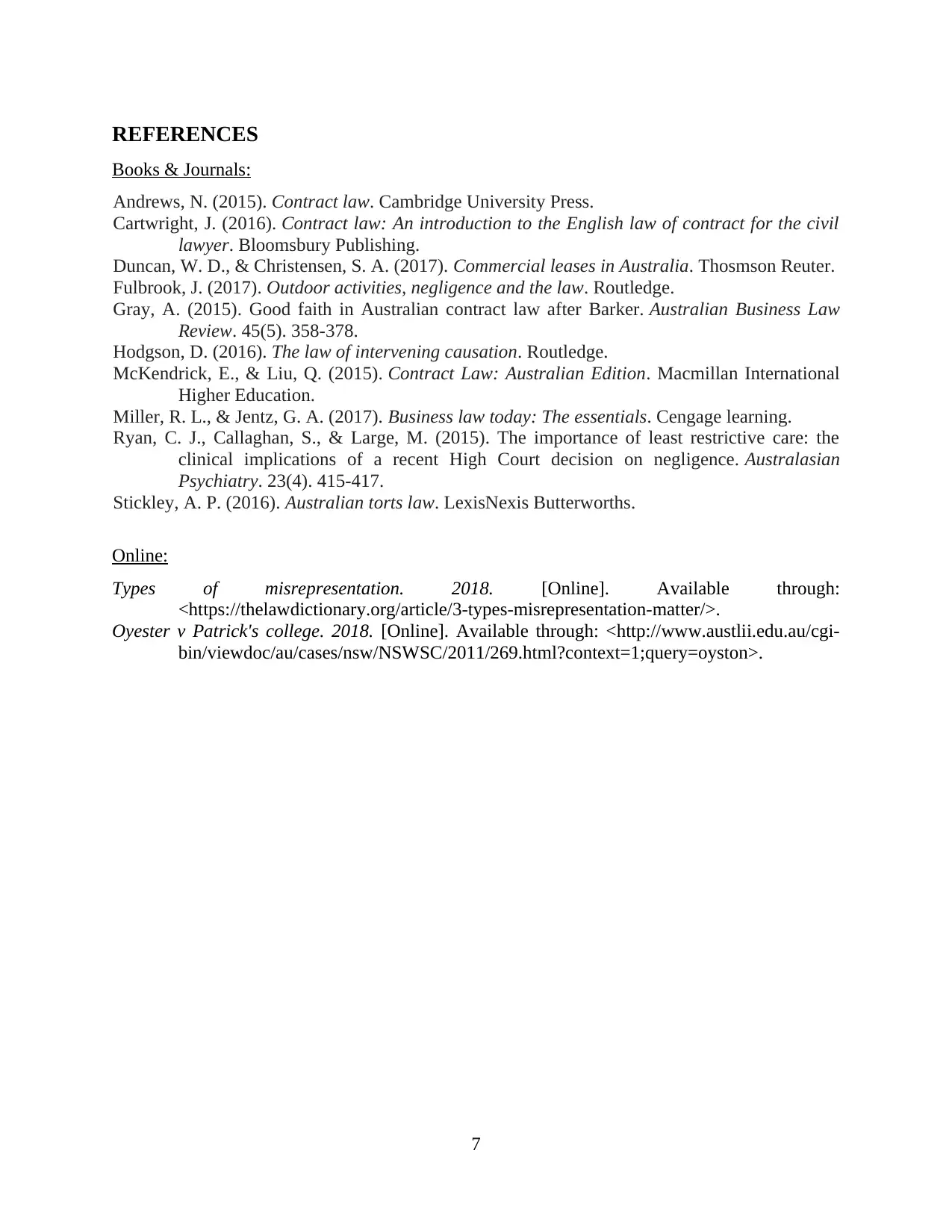
REFERENCES
Books & Journals:
Andrews, N. (2015). Contract law. Cambridge University Press.
Cartwright, J. (2016). Contract law: An introduction to the English law of contract for the civil
lawyer. Bloomsbury Publishing.
Duncan, W. D., & Christensen, S. A. (2017). Commercial leases in Australia. Thosmson Reuter.
Fulbrook, J. (2017). Outdoor activities, negligence and the law. Routledge.
Gray, A. (2015). Good faith in Australian contract law after Barker. Australian Business Law
Review. 45(5). 358-378.
Hodgson, D. (2016). The law of intervening causation. Routledge.
McKendrick, E., & Liu, Q. (2015). Contract Law: Australian Edition. Macmillan International
Higher Education.
Miller, R. L., & Jentz, G. A. (2017). Business law today: The essentials. Cengage learning.
Ryan, C. J., Callaghan, S., & Large, M. (2015). The importance of least restrictive care: the
clinical implications of a recent High Court decision on negligence. Australasian
Psychiatry. 23(4). 415-417.
Stickley, A. P. (2016). Australian torts law. LexisNexis Butterworths.
Online:
Types of misrepresentation. 2018. [Online]. Available through:
<https://thelawdictionary.org/article/3-types-misrepresentation-matter/>.
Oyester v Patrick's college. 2018. [Online]. Available through: <http://www.austlii.edu.au/cgi-
bin/viewdoc/au/cases/nsw/NSWSC/2011/269.html?context=1;query=oyston>.
7
Books & Journals:
Andrews, N. (2015). Contract law. Cambridge University Press.
Cartwright, J. (2016). Contract law: An introduction to the English law of contract for the civil
lawyer. Bloomsbury Publishing.
Duncan, W. D., & Christensen, S. A. (2017). Commercial leases in Australia. Thosmson Reuter.
Fulbrook, J. (2017). Outdoor activities, negligence and the law. Routledge.
Gray, A. (2015). Good faith in Australian contract law after Barker. Australian Business Law
Review. 45(5). 358-378.
Hodgson, D. (2016). The law of intervening causation. Routledge.
McKendrick, E., & Liu, Q. (2015). Contract Law: Australian Edition. Macmillan International
Higher Education.
Miller, R. L., & Jentz, G. A. (2017). Business law today: The essentials. Cengage learning.
Ryan, C. J., Callaghan, S., & Large, M. (2015). The importance of least restrictive care: the
clinical implications of a recent High Court decision on negligence. Australasian
Psychiatry. 23(4). 415-417.
Stickley, A. P. (2016). Australian torts law. LexisNexis Butterworths.
Online:
Types of misrepresentation. 2018. [Online]. Available through:
<https://thelawdictionary.org/article/3-types-misrepresentation-matter/>.
Oyester v Patrick's college. 2018. [Online]. Available through: <http://www.austlii.edu.au/cgi-
bin/viewdoc/au/cases/nsw/NSWSC/2011/269.html?context=1;query=oyston>.
7
1 out of 10
Related Documents
Your All-in-One AI-Powered Toolkit for Academic Success.
+13062052269
info@desklib.com
Available 24*7 on WhatsApp / Email
![[object Object]](/_next/static/media/star-bottom.7253800d.svg)
Unlock your academic potential
Copyright © 2020–2025 A2Z Services. All Rights Reserved. Developed and managed by ZUCOL.





